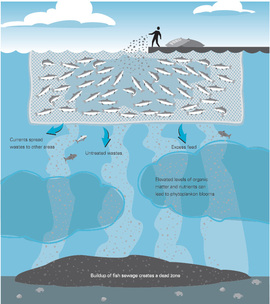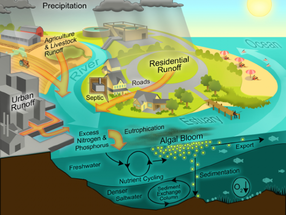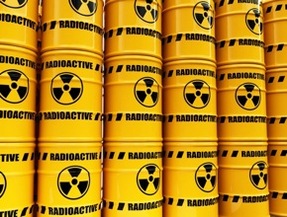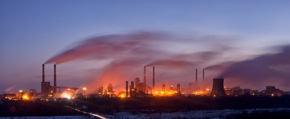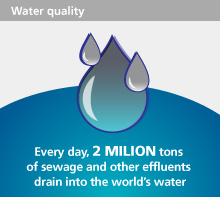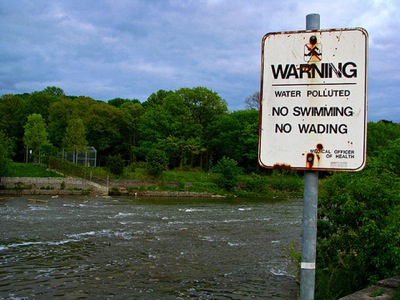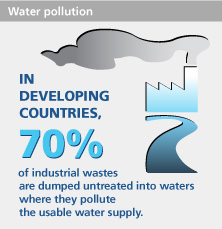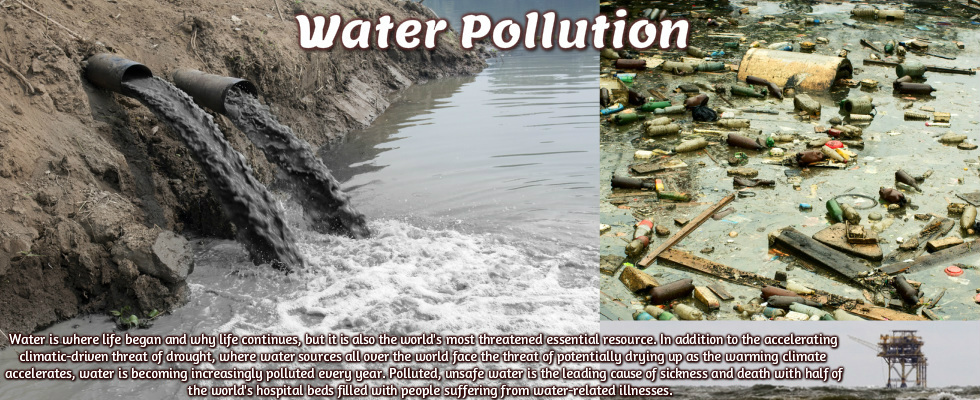
Water Pollution
Water is where life began and why life continues, but it is also the
world's most threatened essential resource. According to
UN-Water, 75% of planet Earth is covered in water. 97.5% of that is ocean and 2.5% is freshwater. 70% of freshwater is divided into glaciers and ice caps and the remaining 30% into land surface water, such as rivers, lakes, ponds and groundwater. Most of the freshwater resources are either unreachable or too polluted, leaving
less that 1% of the world's freshwater,
or about
0.003% of all water on Earth, readily accessible for direct human use.
70% of this unpolluted freshwater is used for irrigation, 22% for industry and 8% for domestic use
(See Also: Finite Freshwater). In addition to the
accelerating climatic-driven threat of drought, where water sources all over the world face the threat of potentially drying up as the
warming climate accelerates, water is becoming increasingly polluted every year. Water pollution affects drinking water, rivers, lakes and oceans all over the world. This consequently harms human health, wildlife and the natural environment. According to the
NIEHS, water pollution is any contamination of water with chemicals or other foreign substances, such as fertilizers and pesticides from agricultural runoff, sewage and food processing waste, lead, mercury and other heavy metals, chemical wastes from industrial discharges, and chemical contamination from hazardous waste sites, that are detrimental to human, plant or animal health.
Polluted, unsafe water is the leading cause of sickness and death with half of the world's hospital beds filled with people suffering from water-related illnesses.
Learn more.
"Industrial pollution is a severe threat to water resources around the world, particularly in the Global South where the view prevails that pollution is the price to pay for progress. The only way to address these hidden dangers in our water is through a preventative approach: Taking action to phase out the use and discharge of hazardous chemicals." ~ Greenpeace International
"Clean and plentiful water is the cornerstone of prosperous communities. Yet as we enter the 21st century, swelling demand and changing climate patterns are draining rivers and aquifers and pollution is threatening the quality of what remains." ~ Natural Resources Defense Council
Causes and Effects of Water Pollution
Industrial Agriculture
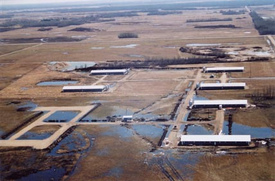
An aerial photo of a factory farm in N.C. with a massive amount of manure. Image: Food and Water Watch
Most water pollution comes from
industrial agriculture, also known as
factory farms, which can contain hundreds of thousands of pigs, chickens, or cows, producing vast amounts of waste and often
generating the waste equivalent to a small city. According to the
EPA, agricultural activity was identified as a source of pollution for 48% of stream and river water and for 41% of lake water in the US.
Water pollution from industrial farms
not only harms ecological areas and wildlife, but it can also sicken and kill people. The manure of cattle, hogs and poultry, which contains
drugs, antibiotics, growth hormones, heavy metals from feed additives, pathogens, even human sewage and excess phosphorus, on these massive farms are over-applied onto fields and pastures as raw, untreated liquefied manure, which is up to
160 times more toxic than raw municipal sewage, creating an enormous threat of pollution to both surface and ground water as this waste runs off into nearby water systems.
Learn more.
Marine Plastic Pollution
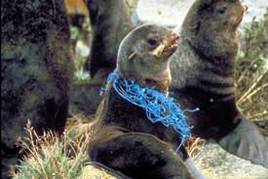
Photo courtesy: NOAA
Most of marine debris comes from land based sources, such as trash and debris in urban runoff, ports and marinas, commercial and industrial facilities, and trash blown out of garbage containers, trucks, and landfills. Most debris found on land eventually makes its way to a stream, storm drain or river and ultimately, the ocean, which is downhill to everything. The rest of the marine debris comes from
ocean-based sources, such as overboard discharges from ships and discarded fishing gear.
Food containers, packaging and plastic bags are among the largest components of the municipal solid waste stream. The quantity of marine debris is increasing in oceans world-wide.
Researchers at the Algalita Marine Research Foundation documented
an increase in plastic debris in the Central Pacific Gyre five-fold between 1997 and 2007, where the baseline in 1997 showed plastic pieces outnumbered plankton on the ocean surface 6:1. In the ocean,
plastic debris injures and kills fish, seabirds and marine mammals.
Marine plastic pollution has impacted at least 267 species worldwide, including 86% of all sea turtle species, 44% of all seabird species and 43% of all marine mammal species. The
impacts include
fatalities as a result of ingestion, starvation, suffocation, infection, drowning, and entanglement. There are now
46,000 pieces of plastic per square kilometer of the world's oceans, killing a million seabirds and 100,000 marine mammals each year. The toxic, small plastic particles engulfing the oceans are frequently mistaken as food by fish and eventually makes its way up the food chain to humans and other marine and even bird species.
Learn more.
Oil Pollution
According to
NASA
, when it comes to mixing oil and water, oceans suffer from far more than an occasional devastating spill. Large oil disasters may grab media attention, but the
hundreds of millions of gallons of oil which quietly ends up in the seas every year
, mostly from non-accidental sources, does not. The graph below may be outdated, but it still shows clearly how big oil spills are just the tip of the iceberg. Much of the pollution occurs in residential areas, chiefly from used engine oil, and in runoff from land and municipal and industrial wastes.
Learn more.

Chart: NASA | Click for source
Other estimates of global input of oil into the marine environment made by the
WHOI, NRC, APPEA, and GESAMP can be found
here. Oil spills and overall oil pollution can have devastating effects on
human health
social and mental stability,
local economies,
wildlife,
birds
and
ecosystems. With regard to water quality,
oil pollution inhibits metabolic activity, interferes with animal membranes and disturbs fishes’ ability to regulate water. According to
Environment Canada, when oil spills make their way to the ocean through land or air, it forms a buoyant layer on the water, which spreads into a thin slick but in weeks can weather into thick, tarry globs, resembling a tough “skin” trapping fresher oil inside.
Storms and weather can also break up oil into small drops that can disperse as small oil particles, which collide in the water with suspended sediment forming “tarballs” of oil, sand, algae and other debris. As
Environment Canada states, "And while slicks and tarballs can be broken down by light and by micro-organisms and plants, it takes a long time. Floating oil can become stuck onto shorelines, or oil particles can collect enough sediment to sink to the water bottom and remain there."
Learn more.
Sewage and Wastewater
An estimated 10 trillion gallons a year of untreated stormwater runs off roofs, roads, parking lots, and other paved surfaces, often through the sewage systems, into rivers and waterways
that serve as drinking water supplies and flow to our beaches, increasing health risks, degrading ecosystems, and damaging tourist economies. This is typically caused by rainfall events flushing nutrients from residential lawns and impervious surfaces into nearby rivers and streams. According to the
World Resources Institute, municipal wastewater treatment plants and industrial wastewater discharges are generally the most controlled sources of nutrients and are often regulated in developed countries, but are still considered “point sources” of nutrient pollution because they discharge nutrients directly to surface waters or groundwater through a pipe or other discrete transport. However, in developing countries,
fewer than 35% of cities have any form of sewage treatment
and even when sewage is treated, it is typically aimed at
removing solids, not nutrients. Households in developed countries often use septic systems when they are not connected to municipal wastewater treatment plants, which are designed to purify waste by leaching it through soils, however,
much of this 'leaching' reaches groundwater or nearby surface waters
polluting the water.
Wastewater can be discharged from a treatment plant into the environment where human exposure may occur
through the potable drinking water supply, recreation, such as swimming, snorkeling, etc., or eating shellfish.
Pathogens commonly found in wastewater effluents
are E. coli, Streptococcus, Salmonella, Shigella, mycobacterium, Pseudomonas aeroginosa, Giardia lamblia and enteroviruses. Tacnia, Ascaris and hookworm ova may be present in raw sewage. All of these microorganisms can make people sick.
Learn more.
Aquaculture
Fish farming is the main form of aquaculture
involving raising fish commercially in tanks or enclosures for food. Aquaculture is
currently the world's fastest growing food production sector, growing at
nearly 10% a year, which is
3 times faster than land-based animal agriculture, with
upwards of 50% of all seafood consumed worldwide being farmed. The average salmon farm is comprised of a
network of submerged net pens made of metal or plastic holding, on average, about 50,000 salmon each, though it's not a rare sight to see up to 80,000 squeezed in one net. There are many aquaculture facilities that are closed and pose no threat of water pollution, however, according to
WWF, "Open net cage fish farms and land-based fish farms can discharge significant amounts of wastewater containing nutrients, chemicals, and pharmaceuticals that impact on the surrounding environment." These aquafarm wastewater contaminants includes
fish excrement, uneaten chemical-laden food, and swarms of parasites, which spread pollution and disease to ocean fish in the area and surrounding ocean. The water flowing out of an aquaculture facility can carry with it
excessive particulates, bacteria, diseased organisms and polluting chemicals harming surrounding habitats, causing algal blooms, poisoning ocean wildlife and other severe disturbances. Furthermore,
feed and fecal matter from these facilities can deplete the dissolved oxygen concentrations around and certainly within the facilities. Even the
anti-fouling agents to keep the cages and pens clean are highly toxic. According to
Farmed and Dangerous, "In open net-cage farming, the use of mesh nets means there is no way to prevent waste feed, which can be laced with
antibiotics
or
pesticides, and fish feces from passing directly into the ocean. The waste from all of these fish can build up under the pens smothering portions of the ocean bottom, contaminating the marine ecosystem and depriving species of oxygen. The
contaminants
from salmon farms have also been linked to elevated levels of mercury in rockfish and parasites, tumors and lesions on ground fish harvested near salmon farms, impacting a
traditional food source
still used by coastal communities."
Learn more.
Diagram illustrating the mechanisms by which aquaculture can contribute to eutrophication and hypoxia. Image Credit: Michael L. Webe | SeaWeb Aquaculture Clearing House
| Click to enlarge
Oceans in Peril: Fish Farming
Eutrophication
Eutrophication
Eutrophication
is a condition in an aquatic ecosystem where high nutrient concentrations stimulate blooms of algae. Although this is a natural process,
human activities, mainly driven by
population and economic growth, energy and fertilizer consumption, land-use conversion and agricultural expansion, climate change and overfishing,
can greatly accelerate eutrophication by increasing the rate at which nutrients and organic substances enter aquatic ecosystems
from their surrounding watersheds causing dead zones to form. According to the
World Resources Institute
, nutrient pollution released to freshwater and coastal areas comes from many diverse sources including agriculture, mainly commercial fertilizers and animal manure, aquaculture, septic tanks, urban wastewater, urban stormwater runoff, industry, and fossil fuel combustion where nutrients enter aquatic ecosystems via the air, surface water or groundwater.
Excess nutrients in coastal waters can cause excessive growth of phytoplankton and algae leading to
a loss of subaquatic vegetation as excessive phytoplankton, microalgae and macroalgae growth reduce light penetration, cause coral reef damage as increased nutrient levels favor algae growth over coral larvae, lead to changes in species composition and biomass and reduce species diversity. Moreover, these
excess nutrients increase the dominance of gelatinous organisms such as jellyfish, create a shift in phytoplankton species composition and create favorable conditions for the development of nuisance, toxic, or otherwise harmful algal blooms and low dissolved oxygen
, which leads to the
formation of hypoxic or “dead” zones
. These oxygen-depleted waters can lead to an ecosystem collapse.
Learn more.
Schematic diagram of the different pathways of nutrient deposition into coastal waters and ensuing processes leading to eutrophication (algal blooms) and hypoxia.
Image Credit: Hans W. Paerl 2006
| Click to enlarge
Radioactive Waste
Nuclear waste
is produced from industrial, medical and scientific processes that use radioactive material. Nuclear waste, which can have harmful effects on ecosystems and human health,
comes from a number of sources, including operations conducted by nuclear power stations producing radioactive waste, nuclear-fuel reprocessing plants and mining and refining of uranium and thorium. It doesn’t take an accident at a nuclear power plant to release radioactivity into the air, water, and soil.
As a matter of regular operation, radiation is released from nuclear plants in the form of liquid, gaseous, and solid radioactive wastes. Government regulations allow radioactive water to be released from nuclear power plants to the environment containing “permissible” levels of contamination, however, since there is no safe threshold to exposure to radiation -
permissible does not mean safe.
Every exposure to radiation increases the risk of damage
to tissues, cells, DNA and other vital molecules and can potentially cause
cell death, genetic mutations, cancers, leukemia, birth defects, and reproductive, immune and endocrine system disorders. There is no safe threshold to exposure to radiation and
many more reasons why nuclear power isn't the answer.
Learn more.
Atmospheric Deposition
What starts as air pollution,
brought about by the combustion of fossil fuels for power generation and transportation, the release of chemical byproducts from industrial and agricultural processes and the incineration of waste, may end up as water pollution as dangerous compounds, such as nitrogen, sulfur, and mercury, emitted into the air fall into surface waters.
Wind can deliver pollutants great distances
across regions and even international boundaries and
can influence the distribution of pollutants, carrying them out of the water and back into the air, only to be re-deposited elsewhere and occur over a large area.
The deposition of air pollutants on land or water also happens in several ways. Wet deposition occurs when air pollutants fall with rain, snow, or fog, whereas dry deposition is the deposition of pollutants as dry particles or gases.
Pollutants can reach water bodies
by direct deposition, falling directly into the water, or through indirect deposition, in which pollutants fall onto land and wash into bodies of water as runoff.
Once these pollutants are in the water, they can have undesirable health and environmental impacts, such as contaminated fish, harmful algal blooms, and unsafe drinking water. In the atmosphere,
the water particles mix with air pollutants, such as carbon dioxide, sulphur dioxide and nitrogen oxides causing the water vapor to become more acidic.
When it rains the water is polluted with these gases, forming acid rain, which pollutes marine habitats such as rivers and lakes and harming aquatic life.
Learn more.



